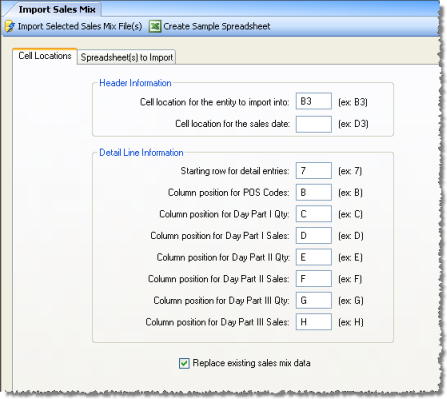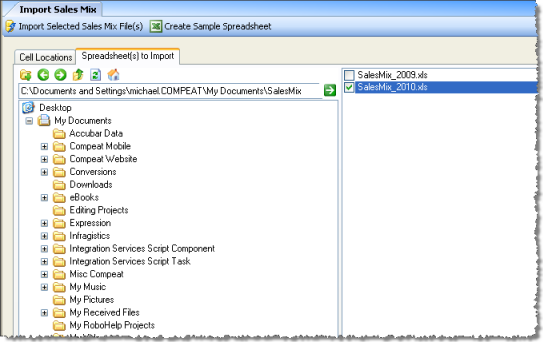
The Import Sales Mix utility allows you to import sales mix data from an Excel spreadsheet. You might, for example, want to create spreadsheets to import recurring sales mix data, such as item sales by day parts.
To successfully import, you must consider a few minor formatting details.
Files must be in .xlsx or .xls file format; these are standard Excel file extensions.
The basis of the import process is simply to indicate to Compeat where each piece of data in your spreadsheet is located. You do this by entering the cell reference for your data in the Cell Locations fields.
You can view a sample spreadsheet by clicking Create Sample Spreadsheet. The data arrangement in the sample spreadsheet corresponds to the example cell references shown next to each field in Compeat. In some cases it may be easiest to rearrange your data to match the sample arrangement.
Do not leave any blank lines between data; when Compeat encounters a blank line, it will stop importing.
Your data must be in the first worksheet of the Excel workbook.
Note: Typically in Excel, when you create a new spreadsheet you will actually be creating a workbook with 3 worksheets; Compeat can only access budget information from the first sheet (named "Sheet 1" by default). You can rename the sheet, as long as it remains the first worksheet in the book (worksheets within a book can easily be dragged to change their order).
Use the Cell Locations tab to define a correlation between the data in your spreadsheet and Compeat. The tab appears similar to the following:

Define the position of the following information:
Note: Next to each field is an example cell reference that corresponds to the cell in the sample spreadsheet. If your data matches the organization of the sample spreadsheet, simply use this cell reference.
Cell location for the entity to import into Enter the cell-reference for the cell containing the entity to which the sales mix data applies.
Cell location for the sales date Enter the cell-reference for the cell containing the apply date for the sales mix data; if you will be importing this sales mix each month, you will need to update the apply date before each time you import.
Starting row for detail entries Enter the first row of your detailed sales mix entries.
Column position for POS Codes Enter the column containing the POS Codes.
Column position for Day Part I Qty Enter the column containing the Day Part 1 Quantities.
Column position for Day Part I Sales Enter the column containing the Day Part 1 Sales.
Column position for Day Part II Qty Enter the column containing the Day Part 2 Quantities.
Column position for Day Part II Sales Enter the column containing the Day Part 2 Sales.
Column position for Day Part III Qty Enter the column containing the Day Part 3 Quantities.
Column position for Day Part III Sales Enter the column containing the Day Part 3 Sales.
Note: Compeat will remember the locations that you specified; if you make all of your sales mix spreadsheets from a template, this will save you from retyping the positions each time you import a sales mix spreadsheet.
This option allows you to select between keeping original data or overwriting with imported data where an existing record and imported record have matching entity numbers, dates, and item IDs.
Check this box if you wish to overwrite existing records with new matching records. Leave unchecked to keep original records and drop matching imported records.
Use the Spreadsheets to Import tab to specify the name of each sales mix spreadsheet that you wish to import; you can import one or more spreadsheets at a time. This tab displays a standard Windows Explorer-type directory tree. From the directory tree, select the directory where your sales mix spreadsheet files are located. The tab appears similar to the following:

Note: It is a good idea to place all of your sales mix files in a single folder dedicated only to sales mix spreadsheet files. This will make it easier to find the correct files.
When a folder is selected, you will see all of the Excel files in that folder displayed on the right side of the screen. Check each sales mix file that you wish to import.
After you have selected the sales mix files that you wish to import, click the Import Selected Sales Mix File(s) button.
Note: Inactive menu items will be excluded from the import.
Once you have imported sales mix data, you can then view it under Reports > Inventory Activity > Sales Mix, or Reports > Miscellaneous > Missing Polling Data.